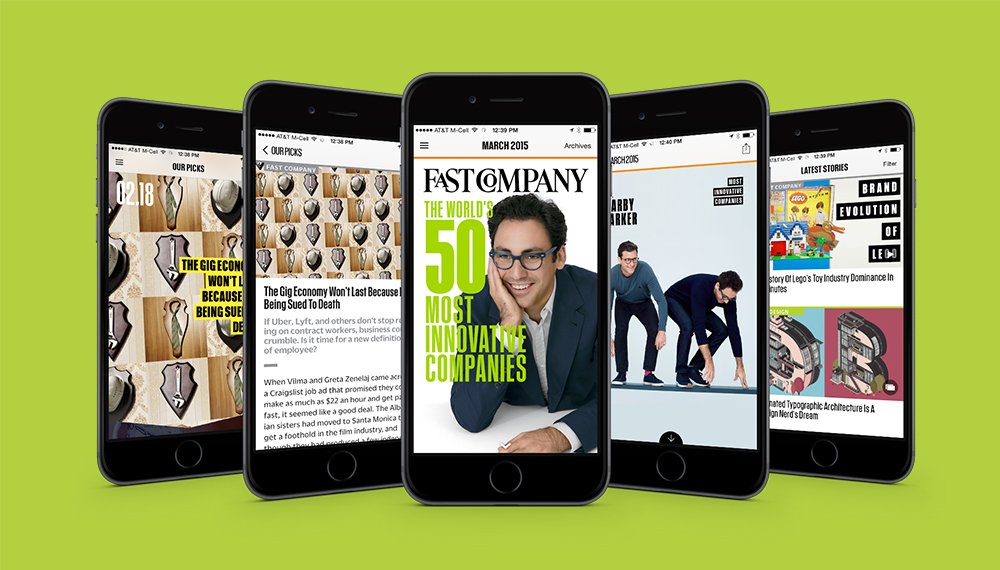I started out writing this month’s article with a focus on what we could say to help you, our readers, navigate what’s next. Technology disruption has been a driving force in how media is consumed, and how publishers now aim to deliver their content in various forms. We’ve been riding the tablet/phablet wave for a few years now. But what’s next, and how can we prepare?
Digital Magazines
This week’s joint announcement by Adobe and Fast Company about their next-generation digital publishing app gives us a glimpse of how content publishers can take their delivery to the next level. The manual processes required to create digital publishing apps have had a high cost, and have restricted how much content can be delivered. Being able to move to an untethered, daily publishing model will greatly expand those opportunities.
In the announcement, Adobe described the working experience with Fast Company and the challenges: “The discussion centered around what defined a ‘magazine’ in this modern age of digital consumption, where readers are increasingly engaging with brands on the web, on mobile devices, at all times of day, with increasing frequency and with broadly different expectations.
“While revenues from digital divisions of many publishers are growing, what has becoming increasingly clear is that the web traffic is often very fleeting. Average visit lengths across the web are measured in seconds instead of minutes, a vast majority of traffic comes from search engines or links from email newsletters, and repeat visitors per month can be scarce. On the other hand, print and digital subscribers are highly engaged and valuable to publishers, but surprisingly don’t tend to consume as much daily content on the web.”
Fast Company’s editor in chief, Bob Safian, stated in the announcement, “One thing is certain: Media will look far different than it does today. We need to continually iterate on our content, in both form and substance, if we want to remain relevant and useful to our readers.”
We’ve also been watching as Amazon founder Jeff Bezos pushes the The Washington Post full throttle into the digital age. What can we learn from that?
Next Technologies
The impending release of the Apple Watch, due in April, adds another facet to how users will engage with a device, and expect it to drive them to relevant information and content. Wearable technologies are the next-generation devices, and as publishers, how do we look forward and predict how we can be there, at the right time, in the right form? How will our content apply, need to be structured, and rationed out to meet the reader at the right time?
It goes without saying (but I’ll say it anyway) that the smartphone and tablet have had a huge impact on how we consume, share, and create content. And that applies not only to how content is published, but equally to how “readers” view, respond to, and create their own content.
Remember when Seybold predicted that smartphones would become the camera for the majority? We gasped in shock at the suggestion. And look now at how the accessibility of smartphone cameras has changed the landscape of media. Remember that GPS device that seemed so leading edge for a short time but was quickly replaced by the mobile device? Same thing.
And who saw the tablet coming, and the far-reaching impact it would have? Phones and tablets were expected to replace the computer for some needs, and while that has happened to some degree, their real impact has been creating a whole new consumption space and model for how we experience and use information (and I intentionally mean information rather than content here).
If you’re interested in how devices (screens) and our use of them are being analyzed, you should follow the studies being conducted by USC Annenberg’s Center for the Digital Future, led by director Jeffrey Cole. Its 2014 report, Surveying the Digital Future, will give you some great insights into the shifts of device use and, just as interesting, a look at the history based upon geographic/economic regions.
Technology devices and their fast-changing evolution are quickly pushing how we need to create and deliver content. Publishers not investing in reshaping their content and distribution models will be left behind, and knowing this, they are reshaping teams, process, and technologies.
This disruption has occurred within a very short time frame, in what one would consider the modern era of publishing. If trends are to be taken into account, what’s next, and how quickly do publishers need to be able to respond?
All that we see points to the need to have a solid content delivery model in place, regardless of target or device. Keeping content centralized, well-structured, and deliverable via a variety of methods and formats sets the stage to more easily adapt to the next disruption.
Posted by: Margot Knorr Mancini




